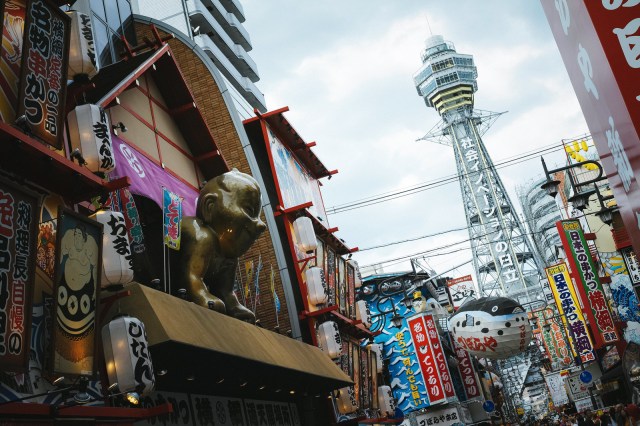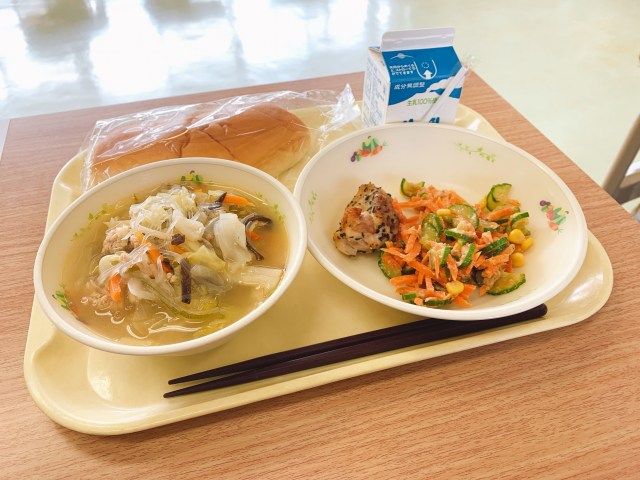
Logistical mishaps and contradicting guidelines hinder what could be one of the best ways to lower COVID-19 community transmission.
While Japan has kept the number of imported cases of COVID-19 low with restricted borders, the nation is struggling to contain the spread of COVID-19 domestically as larger cities such as Tokyo grapple with a fourth wave of infections. One of the most hard-hit areas in particular has been Osaka, and given the circumstances, closing schools and transitioning to remote learning is one of the most logical things to do. However, attempts by Osaka City’s board of education have been bombarded with logistical hiccups and confusing guidelines which have raised anger among educators.
▼ The skyline of Osaka’s central hub, pre-COVID-19 and pre-pufferfish-exodus.
Osaka is one of the few cities in Japan attempting a transition to remote learning — which is not only important in reducing the local transmission of COVID-19, but an opportunity to set a leading example within a country where constitutional limits forbid nationwide mandates even in a public health crisis — and some schools have been going back and forth between staying closed or resuming lessons as usual.
Unfortunately, the city’s efforts have been bogged down in multiple different ways, and we’ve found three main issues hindering Osaka’s transition to remote learning for elementary as well as junior high school students.
▼ A visual representation of how we imagine Osaka educators to be feeling right now.
The first issue is ensuring student accessibility to remote learning technology. While MEXT (Ministry of Education, Culture, Sports, Science and Technology) jumpstarted a program called the GIGA School Initiative to provide Internet-connecting devices, particularly to elementary and junior high school students after the pandemic’s onset, according to a recent study performed by the initiative, the ratio of students to Internet-connecting devices, whether smartphone, tablet or computer, is at one device per five students on both a national level and in Osaka Prefecture.
▼ Of the devices delivered, it seems tablets are the most common, though this is no surprise given their ease of use and similarity to smartphone software.
Of course, simply ensuring everyone has the tech doesn’t mean everything’s ready to go, and this leads to a second hurdle: adapting to remote learning, which has been a struggle for many. From familiarizing themselves with remote-teaching methods, easing students into taking classes online, and the troubleshooting of tech issues, teachers in Osaka have signaled that they are falling behind with little time to spare for catching up. It doesn’t help that Osaka City’s board of education had set a rather strict deadline, announcing its new remote-learning policy for elementary and middle schools on April 22 and calling for schools in the area to begin remote learning on April 25, which only allowed three days for instructors, school staff, students, and parents to prepare for an education style which is still extremely rare in Japan.
▼ No pressure for the local IT staff working at schools!
But what has truly raised the ire of Osaka City educators isn’t the logistical slowdowns nor the lack of time given for the transition, but a guideline directing students to return to school for lunch during the remote-learning period. So far, the guidelines have received considerable blowback from both school staff and Japanese netizens alike:
“Aren’t… aren’t we getting our priorities completely backward if we make the students learn online but still go to school for lunch?”
“And all this time we keep getting told not to dine together.”
“They should consider the school staff more and also not put kids at risk…”
“But isn’t eating when infectious droplets spread the most?”
“If they want to really do this, then they better figure out a way to protect the staff preparing school lunches.”
▼ A picture of the typical lunch provided by schools.
Granted, schools offering lunch is a vital part of the community safety net, especially for students affected by food poverty. However, forcing every student, regardless of their situation, to return to school for lunch seems to contradict the purpose of keeping schools closed in the first place, and with cases rising, the anger expressed by teachers and locals is understandable. At the end of the day, it may seem like common sense to shut down schools, but then again, some pretty wild takes have been given in the past year by local leaders regarding preventative measures against COVID-19.
▼ It takes a village for even one small part of a school’s daily operations, and students as well as staff deserve a safe working environment.
During a time period riddled with anxiety and uncertainty, the last thing teachers, who are viewed but not necessarily treated as one of the backbones of human society, and students need is a higher risk of contracting COVID-19. And while it’s too early to determine how Osaka City’s transition to remote learning will pan out, we sincerely hope policy adjustments are made as it’s believed that vaccine rollout won’t reach the general public until mid-July at the earliest.
Related: MEXT Giga School Initiative
Source: Yahoo News! via Hachima Kiko, Sankei News
Top image: Pakutaso
Insert images: Pakutaso (1, 2, 3, 4), Photo AC, Wikimedia/Osamu Iwasaki
● Want to hear about SoraNews24’s latest articles as soon as they’re published? Follow us on Facebook and Twitter!






 1 in 20 Japanese junior high school students regularly missing school, government study finds
1 in 20 Japanese junior high school students regularly missing school, government study finds Students go nearly a year without textbooks after teacher forgets to hand them out
Students go nearly a year without textbooks after teacher forgets to hand them out Kyoto families angered by new policy forcing high school students to buy tablets at own expense
Kyoto families angered by new policy forcing high school students to buy tablets at own expense Shibuya gives each public elementary and junior high student a Surface Go 2 tablet for school
Shibuya gives each public elementary and junior high student a Surface Go 2 tablet for school Teacher disciplined for drinking alcohol during class in Japan
Teacher disciplined for drinking alcohol during class in Japan Foreigner’s request for help in Tokyo makes us sad for the state of society
Foreigner’s request for help in Tokyo makes us sad for the state of society Japanese-style accommodation at the new Premium Dormy Inn hotel in Asakusa will blow your mind
Japanese-style accommodation at the new Premium Dormy Inn hotel in Asakusa will blow your mind Mikado Coffee is a 76-year-old coffee chain with a major celebrity connection
Mikado Coffee is a 76-year-old coffee chain with a major celebrity connection Japanese ramen restaurants under pressure from new yen banknotes
Japanese ramen restaurants under pressure from new yen banknotes Resol Poshtel: Cheap capsule hotel in Tokyo is a hit with overseas visitors, and we find out why
Resol Poshtel: Cheap capsule hotel in Tokyo is a hit with overseas visitors, and we find out why You Can Have Your Very Own Whale Party on iPhone Messages In Just a Few Simple Steps
You Can Have Your Very Own Whale Party on iPhone Messages In Just a Few Simple Steps Seaside scenery, history, and so many desserts on Yokohama’s Akai Kutsu【Japan Loop Buses】
Seaside scenery, history, and so many desserts on Yokohama’s Akai Kutsu【Japan Loop Buses】 Japanese city loses residents’ personal data, which was on paper being transported on a windy day
Japanese city loses residents’ personal data, which was on paper being transported on a windy day Ultra-realistic cat latte art blows us away, puts us off our coffee
Ultra-realistic cat latte art blows us away, puts us off our coffee What do you eat when you catch a cold? We asked 11 of our Japanese reporters
What do you eat when you catch a cold? We asked 11 of our Japanese reporters McDonald’s new Happy Meals offer up cute and practical Sanrio lifestyle goods
McDonald’s new Happy Meals offer up cute and practical Sanrio lifestyle goods French Fries Bread in Tokyo’s Shibuya becomes a hit on social media
French Fries Bread in Tokyo’s Shibuya becomes a hit on social media Red light district sushi restaurant in Tokyo shows us just how wrong we were about it
Red light district sushi restaurant in Tokyo shows us just how wrong we were about it New private rooms on Tokaido Shinkansen change the way we travel from Tokyo to Kyoto
New private rooms on Tokaido Shinkansen change the way we travel from Tokyo to Kyoto Tokyo Tsukiji fish market site to be redeveloped with 50,000-seat stadium, hotel, shopping center
Tokyo Tsukiji fish market site to be redeveloped with 50,000-seat stadium, hotel, shopping center Beautiful Ghibli sealing wax kits let you create accessories and elegant letter decorations【Pics】
Beautiful Ghibli sealing wax kits let you create accessories and elegant letter decorations【Pics】 Secret Kitchen bento serves Japanese flowers, birds, wind and moon in a box, but is it worth it?
Secret Kitchen bento serves Japanese flowers, birds, wind and moon in a box, but is it worth it? New definition of “Japanese whiskey” goes into effect to prevent fakes from fooling overseas buyers
New definition of “Japanese whiskey” goes into effect to prevent fakes from fooling overseas buyers Our Japanese reporter visits Costco in the U.S., finds super American and very Japanese things
Our Japanese reporter visits Costco in the U.S., finds super American and very Japanese things Studio Ghibli releases Kiki’s Delivery Service chocolate cake pouches in Japan
Studio Ghibli releases Kiki’s Delivery Service chocolate cake pouches in Japan All-you-can-drink Starbucks and amazing views part of Tokyo’s new 170 meter-high sky lounge
All-you-can-drink Starbucks and amazing views part of Tokyo’s new 170 meter-high sky lounge More foreign tourists than ever before in history visited Japan last month
More foreign tourists than ever before in history visited Japan last month New Pokémon cakes let you eat your way through Pikachu and all the Eevee evolutions
New Pokémon cakes let you eat your way through Pikachu and all the Eevee evolutions Disney princesses get official manga makeovers for Manga Princess Cafe opening in Tokyo
Disney princesses get official manga makeovers for Manga Princess Cafe opening in Tokyo Sales of Japan’s most convenient train ticket/shopping payment cards suspended indefinitely
Sales of Japan’s most convenient train ticket/shopping payment cards suspended indefinitely Sold-out Studio Ghibli desktop humidifiers are back so Totoro can help you through the dry season
Sold-out Studio Ghibli desktop humidifiers are back so Totoro can help you through the dry season Japanese government to make first change to romanization spelling rules since the 1950s
Japanese government to make first change to romanization spelling rules since the 1950s Ghibli founders Toshio Suzuki and Hayao Miyazaki contribute to Japanese whisky Totoro label design
Ghibli founders Toshio Suzuki and Hayao Miyazaki contribute to Japanese whisky Totoro label design Doraemon found buried at sea as scene from 1993 anime becomes real life【Photos】
Doraemon found buried at sea as scene from 1993 anime becomes real life【Photos】 Tokyo’s most famous Starbucks is closed
Tokyo’s most famous Starbucks is closed One Piece characters’ nationalities revealed, but fans have mixed opinions
One Piece characters’ nationalities revealed, but fans have mixed opinions We asked a Uniqlo employee what four things we should buy and their suggestions didn’t disappoint
We asked a Uniqlo employee what four things we should buy and their suggestions didn’t disappoint Petition to allow students to choose what they wear to school gathers almost 19,000 signatures
Petition to allow students to choose what they wear to school gathers almost 19,000 signatures “Let them eat furikake!” says Mayor Hashimoto as Osaka school lunch saga rumbles on
“Let them eat furikake!” says Mayor Hashimoto as Osaka school lunch saga rumbles on Osaka elementary school becomes first in Japan to have a police box established on campus
Osaka elementary school becomes first in Japan to have a police box established on campus Japan’s most famous anime/manga artist trade school now has a fully online program
Japan’s most famous anime/manga artist trade school now has a fully online program Japanese high school requires teens to kneel and bow for teaches, receives harsh online backlash
Japanese high school requires teens to kneel and bow for teaches, receives harsh online backlash Naturally brown-haired Osaka student sues government for forcing her to dye her hair black
Naturally brown-haired Osaka student sues government for forcing her to dye her hair black Japanese schools are losing their pools due to rising maintenance costs and aging facilities
Japanese schools are losing their pools due to rising maintenance costs and aging facilities Japanese PM asks schools around Japan to close as coronavirus cases rise
Japanese PM asks schools around Japan to close as coronavirus cases rise Under 35 percent of middle school English teachers in Japan meet government proficiency benchmark
Under 35 percent of middle school English teachers in Japan meet government proficiency benchmark Japanese teacher beats up student for making fun of his body by calling him anime character name
Japanese teacher beats up student for making fun of his body by calling him anime character name Junior high student shut down 444 school websites to “remind teachers they are incompetent”
Junior high student shut down 444 school websites to “remind teachers they are incompetent” Over half of Japanese students in nationwide test score zero percent in English speaking section
Over half of Japanese students in nationwide test score zero percent in English speaking section To prevent heatstroke and COVID-19, Ibaraki vending machines dispense free cold water to students
To prevent heatstroke and COVID-19, Ibaraki vending machines dispense free cold water to students Japanese public school to allow male students to wear skirts, chest ribbons as part of uniform
Japanese public school to allow male students to wear skirts, chest ribbons as part of uniform Majority of Nagasaki high schools and middle schools have white-underwear-only rules, study finds
Majority of Nagasaki high schools and middle schools have white-underwear-only rules, study finds Foreign English teacher in Japan calls student’s ability garbage, says it was an “American joke”
Foreign English teacher in Japan calls student’s ability garbage, says it was an “American joke”
Leave a Reply